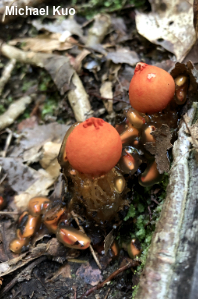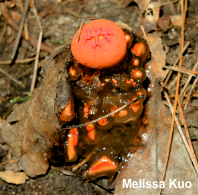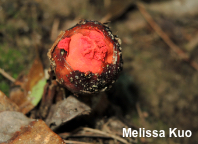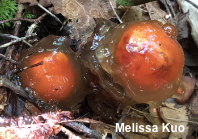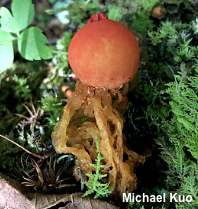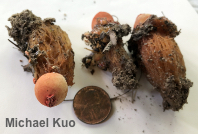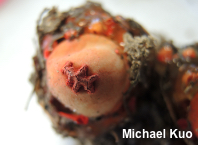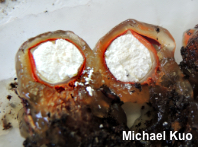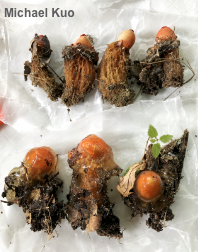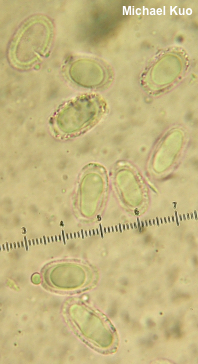| Major Groups > Puffballs > Calostoma cinnabarinum |

|
Calostoma cinnabarinum [ Basidiomycota > Boletales > Sclerodermataceae > Calostoma . . . ] by Michael Kuo Readers who are used to my admonitions against identifying mushrooms by comparing them to photographs may be surprised to hear me say that Calostoma cinnabarinum is probably an exception. Roger Phillips (1991/2005) calls Calostoma cinnabarinum the "stalked puffball-in-aspic," which is a very apt description of this beautifully disgusting fungus, since it sheds gelatinous red chunks that slide down its stem and surround it. DNA research has located the genus Calostoma within the bolete order, along with some other rather strange bedfellows—and Wilson and collaborators (2007) used isotopic, molecular, and morphological analysis to demonstrate that Calostoma cinnabarinum is mycorrhizal (like boletes), rather than saprobic as had previously been assumed. Calostoma lutescens has a yellow (rather than red) spore case, a longer stem, a "collar" under the spore case, and round, pitted spores; Calostoma ravenelii has a yellowish spore case with no collar, and ellipsoid spores. Both of these species lack the gelatinous covering. "Calostoma cinnabarina" is a Latin error found in some sources. Thanks to Sherwood Forest Friends for facilitating collection of specimens. Description: Ecology: Mycorrhizal with oaks; growing alone or gregariously, often in moss beds or in low-lying, wet areas; spring through fall; eastern North America, Texas, and perhaps in the Southwest; also Central America and South America, and reported from Asia; apparently more common at higher elevations within its range. The illustrated and described collections are from North Carolina. Fruiting Body: A spore case sitting atop a stem structure; at first covered with a thick, gelatinous covering that sloughs away, slides down the stem, and then surrounds the stem base until drying up and disappearing. Spore case 11–25 mm wide; 11–25 mm high; subglobose; cinnabar red when young and fresh, fading to reddish orange; apex developing a bright red, ridged peristome that looks a bit like a stitched scar; at first covered with gelatin but dry and finely dusted after the gelatin sloughs away; interior filled with whitish to yellowish spore dust. Stem structure 2–5 cm high; 1–2.5 cm wide; composed of tightly wound cords; soft; dull orangish. Microscopic Features: Spores 10–19 x 6–10 µm; ellipsoid; finely punctate; walls about 0.5 µm thick; uniguttulate (occasionally biguttulate) and hyaline in KOH. Capillitial threads 4–6 µm wide; walls to 1 µm thick; hyaline in KOH; clamped. REFERENCES: Corda, 1809. (Saccardo, 1888; Reed, 1910; Coker & Couch, 1928; Smith, Smith & Weber, 1981; Castro-Mendoza et al., 1983; Weber & Smith, 1985; Arora, 1986; Phillips, 1991/2005; Lincoff, 1992; Metzler & Metzler, 1992; Hughey et al., 2000; Roody, 2003; Calonge at al., 2005; Miller & Miller, 2006; Basaeia et al., 2007; Wilson et al., 2007; Kuo & Methven, 2010; Trierveiler-Pereira et al., 2013; Baroni, 2017; Woehrel & Light, 2017; Elliott & Stephenson, 2018.) Herb. Kuo 08091912, 08091913. This site contains no information about the edibility or toxicity of mushrooms. |
© MushroomExpert.Com |
|
Cite this page as: Kuo, M. (2019, December). Calostoma cinnabarinum. Retrieved from the MushroomExpert.Com Web site: http://www.mushroomexpert.com/calostoma_cinnabarinum.html |
